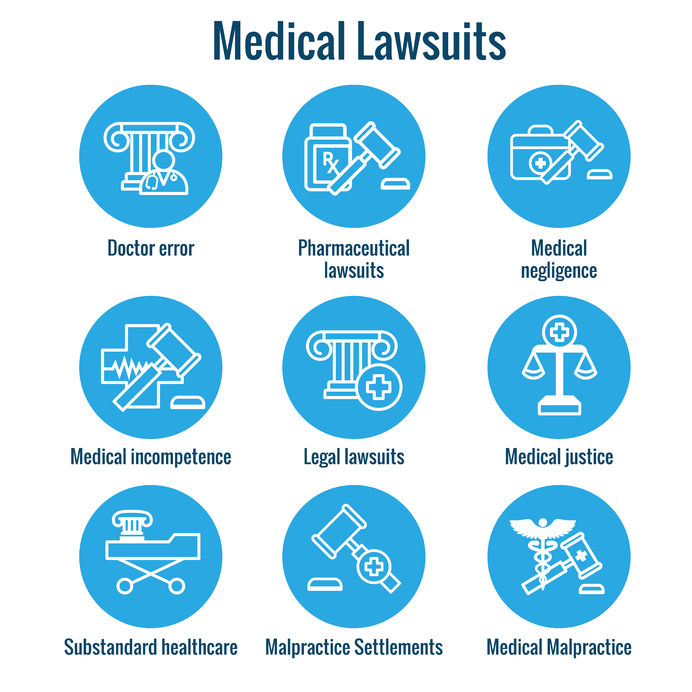

Medical Malpractice Damages
Medical Malpractice Damages are meant to compensate the victim or the victim’s family for a variety of wrongs from loss of employment and earnings to mental anguish. If you or a loved one has been injured by medical malpractice then it is good to have a clear understanding of the damages you might reasonably recover as well as how you will go about receiving them. It is important to know that laws vary state by state so receiving the guidance of a local medical malpractice lawyer will be of huge value.
What Types of Damages Can I Recover in a Medical Malpractice Lawsuit?
Once your medical malpractice attorney has proven that medical malpractice caused your problems, a list of reasonable injuries will be identified along with a dollar amount for each. The three categories of damages available in medical malpractice cases are general, special, and punitive.
General damages. General damages are the portion of a patient’s suffering that are real but by nature cannot be paired with a definite cost. Common examples of general damages include physical and mental pain and suffering, loss of enjoyment of life, loss of future earning capacity and loss of quality of spousal relationship. Clearly, every case will be slightly different and it is up to the judge to decide on the exact value of each loss or injury. A dollar value is usually determined after evidence of the suffering is provided by the victim or family members as well as an expert who is called to describe common consequences of the particular injuries sustained. The age of the victim and the severity of the injury will play a role in the amount of damage assigned since they will greatly impact the person’s need and ability to earn a salary.
Special damages. Special damages are meant to compensate for easily quantifiable expenses such as medical bills and time off of work. There may be some guesswork involved in estimating future medical expenses but special damages are a fairly exact science. In many states an expert is not called to testify about special damages because a certified copy of your medical bills is considered legitimate evidence.
Punitive damages. Punitive damages are much harder to prove and therefore it is more difficult to receive this compensation. Washington State does not allow punitive damages in most cases. The law varies from state to state but in essence your lawyer must prove that the doctor knew that he or she was behaving in a manner harmful to the patient. A horrific example would be that of a surgeon who intentionally didn’t complete a surgery successfully in order to ensure a second surgery. The amount of the damages is left to the judge or jury but is generally not allowed to be more than three to four times the amount of the special or general damages.
State Limitations on Damages
Although many states place a cap on the amount of damages a patient or their family can recover from medical malpractice, the specific limitations vary greatly. Generally, Washington State does not place caps on damages. In some states, a limit of say $650,000 is placed on all damages combined. Other states break it up by type of damage; for example the law may limit general damages but not special or punitive damages. It is also common that any money received from other sources like an insurance claim will be deducted from the amount owed by the doctor. Another common limitation is the amount that a patient’s attorney can charge for a medical malpractice case.
Damages for the Death of the Patient
Damages for the death of a patient have their own set of laws called survival statutes and wrongful death statutes.
Survival statutes. Survival statutes are meant to allow the victims’ heirs or estate to recover damages occurred from the time of the original medical malpractice until the time of death. Survival statutes damages include everything in a regular medical malpractice case minus damages for future earnings or expenses. Some survival statutes include money for funeral expenses.
Wrongful death statutes. Wrongful death statutes are meant to compensate the victim’s heirs for their future monetary loss. There is a fairly thorough calculation used to determine the dollar amount including a projection of future salary and the patient’s spending, savings and working habits. In most states only the victim’s spouse and children will be able to claim a wrongful death statute and loss of companionship or emotional harm have not been traditionally allowed.
Medical malpractice law is complicated and confusing unless you know the law inside and out. Tario & Associates, P.S. focuses on medical malpractice with many years of experience winning claims. Call the expert medical malpractice attorneys at Tario & Associates, P.S. if you or a loved one were injured by a wrong medical diagnosis or treatment. We will hear the specifics of your case and fight for the compensation you deserve. Contact us today!
Read More

When Can I Claim Medical Malpractice?
Simply stated, medical malpractice occurs when a patient is harmed by a doctor (or other medical professional) who has failed to competently perform his or her medical duties. Although specific rules vary by state, there are some basic medical malpractice principles that can be applied anywhere.
Medical Malpractice Overview
Basic Requirements for a Medical Malpractice Claim
Your lawyer must prove all the following points:
A doctor-patient relationship existed. This means that you hired the doctor for medical advice/treatment and the doctor agreed to be hired. If a doctor took you on as a patient, then the relationship is easy to prove. The situation is usually only complicated if there was a consulting physician who did not treat you directly.
The doctor was negligent. Medical malpractice means that the doctor was not reasonably skilled, competent or careful in their diagnosis or treatment of your case. Further, you must prove that this misdiagnosis or erroneous treatment caused you harm that a different doctor would not have caused. It is not enough to say that you are not happy with the outcome or that their care was not the best possible available. In most states, your lawyer will need to present a medical expert to show what standards of treatment would be considered reasonably skillful and careful with regard to your case.
The doctor’s negligence caused the injury. Since most people go to a doctor when they are already sick, it is imperative that the doctor’s negligence caused the injury, not the illness itself. For example, if a patient dies after being diagnosed with brain cancer but the doctor didn’t try a reasonable course of treatment to cure it then he could be deemed negligent. Again, your attorney will likely be asked to present a medical expert to testify that the doctor’s negligence caused the death or injury.
The injury led to specific damages. It is not enough to prove that the doctor’s performance was below a reasonable standard of care; you must have experienced harm from the negligence. Harm can include physical pain, unnecessary medical bills, additional lost work and earning capacity, and mental anguish.
Common Types of Medical Malpractice
Although there are quite a few situations that could be deemed a legitimate medical malpractice case, most claims fall into one of the following three categories:
Failure to diagnose. It starts with a diagnosis. If a different and more competent doctor would have discovered the illness or made a different or more accurate diagnosis, which would have then led to a better outcome than what was achieved, then the patient may have a viable medical malpractice claim.
Improper treatment. If the patient is treated for an illness in an incompetent way, or in a way that no reasonable doctor would treat for that illness then you likely have a claim. You may also have a claim if the correct treatment was chosen but administered incorrectly and therefore caused harm.
Failure to warn a patient of known risks. A physician is required to warn patients of known risks of a surgery, procedure or drug; this is called the duty of informed consent. If the patient would have requested an alternate treatment had they known about the risks, the doctor could be held liable if the treatment causes injury that should have been communicated.
Many states have specific rules for medical malpractice including limits on damages, requirements to submit your claim to your doctor or a medical malpractice review panel before filing with a lawyer, and strict timeframe’s for filing from the date of the injury or from the time a patient could have known about the injury.
Medical malpractice law is complicated and confusing unless you know the law inside and out. Tario & Associates, P.S. focuses on medical malpractice with many years of experience winning claims. Call the expert medical malpractice attorneys at Tario & Associates, P.S. if you or a loved one were injured by a wrong medical diagnosis or treatment. We will hear the specifics of your case and fight for the compensation you deserve. Contact us today!
Read More